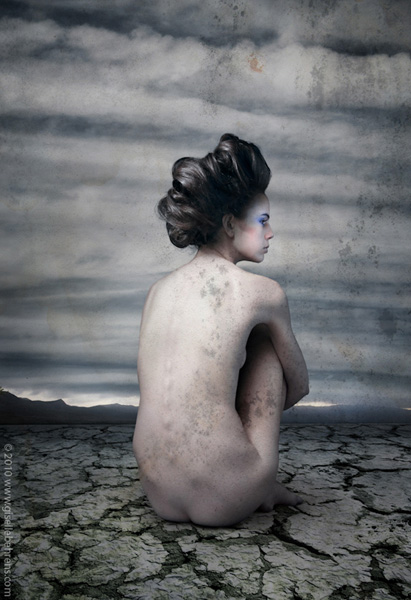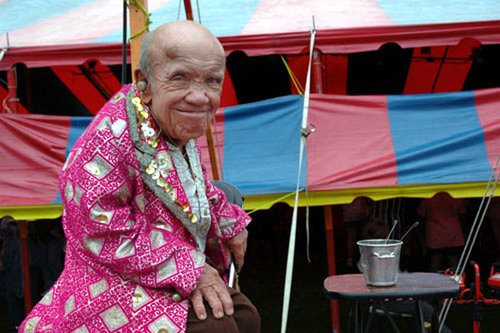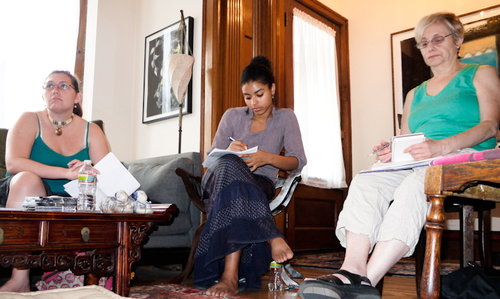by Rhonda Schaller
Create a DIY Strategy for Exhibiting Your Work: Part Two of a series.

© Giselle Behrens Thesis 4 collection Rhonda Schaller
Alternative #2: Showing in alternative spaces
Some of the alternative spaces with entrepreneurial aspects/frameworks are: Art registries and flat files; online galleries; artist communities; co-ops; collaborative spaces; artist run spaces; non profit galleries and art centers; artist fairs; open studios; private art salons; studio galleries; public art commissions; online auctions; eBay. Plus of course corporate lobbies, subways, taxi cabs, street corners, cafes, restaurants; empty lots, building walls, fields, trees, any space that can be redefined and transformed through art and observation.
Also, there are juried shows, open calls, artist residencies, public art projects, guerilla art happenings, unconventional commercial galleries, University galleries, and museum collections and biennials.
Online galleries and Art registries
I really like online galleries and art files/registries. I run an online gallery which features works by photographer John Sumner and others.

© John Sumner Universal Image #9, courtesy of Rhonda Schaller/Schaller + Jaquish Art Projects)
Many curators and gallerists find artists for group shows by looking through online galleries and art file sites. Curators of non-profit galleries and alternative art centers will use them to curate their own shows. Many years ago I remember being included in “Night of 1000 Drawings” show at Artist Space, in support of their mission. This was because I had my work on file in their art registry, and was invited to participate. It was great, I did and the drawing sold, and I had a new collector to add to my mailing list.
Independent curators will visit art registries to find artists to include in their proposals for shows. Research the sites and registries you feel an affinity towards, either because of their mission statement, or you can relate to the other work they have on file. Google them, see if they are being talked about on blogs or if there is any feedback to help you pick and choose. Then follow your intuition, if it feels like a good fit – go for it.
Being part of artist registries and online art files can lead to exhibition opportunities, and sales to private collectors from all over the country, and the world.
Portfolio Sites
To create a visibility trail, it is important that your work be searchable. In addition to your own website, there are portfolio sites that have multiple artists which are great “finds.” There are some wonderful portfolio sites to join, and then there are those to avoid. You will have to decide, based on your goals which ones make sense to you.

© Dasha Ziborova Love your Barbie 2 courtesy of Rhonda Schaller/Schaller + Jaquish Art Projects)
Some charge a monthly fee. I see nothing wrong with a membership fee, a monthly fee to house your work on a site, month after month. Again, research the reach of each site, see the artists who participate and research what a variety of artists likes or dislikes have been with their involvement.
Then, weigh it against your goals. Are you looking to increase your audience, experience, or sales? Ask yourself, which portfolio site has work that you relate to and feel you would like to be a part of? Then go for it. I also see nothing wrong with an application fee, every university charges you to apply to their BFA or MFA program. Every artist needs to decide what the ROI (return on investment) is for any exhibition, and then budget and participate or not accordingly.
A few sites I like are Re-title. com, Artslant.com, Saatchi online, Ugallery.com, and wooloo.org, and let’s not forget about etsy. There are many others. There are some artist communities as well that live “online’ where you might want to consider uploading images, resume and artist statement. Back in the day there was MySpace; now people use a combination of portfolio sites.
Lately I’ve seen artists begin to use LinkedIn for slideshares of their work, or link to portfolio sites like the behance network which focuses on design. I find this to be a really interesting development. Linkedin.com is a professional networking site that has 45 million users. Many everyday people collect art, and I would be curious to see how audience development builds for artists using these sites. Some old standards are deviant art; absolute arts; artists register; and let us not forget eBay storefronts.
Now, how do you decide which ones are worth the effort? We go back to your goals. Who do you want to find you? Where do they hang out and where will they look for what you have to offer?
Talk to other artists who are using these sites, and ask questions! Find out through networking and researching if your audience visits the sites you are considering. If you do not know, then try it for a while, and then assess it. Is the ROI (return on your investment) of either time or money being returned to you in ways you want, in ways that make sense for you?
Find role models to help you explore alternative spaces
There are so many great artists out there doing alternative shows in alternative spaces to use as role models. Perhaps your work is based on social or political beliefs, and it plays best in public places such as plazas, lobbies, rooftops, and parks. Your work does not have to float in a sea of white walls in a gallery setting to be valid or have meaning.
Perhaps you work with ice and cast away materials, and your work degrades over time, commenting on our planned obsolescence culture. There is an artist in Slovenia who I love who has been doing this for years, Elena Fajt who works with hair that salons throw away.
Authentic artists doing authentic alternative work in alternative venues – some they have created themselves some are hybrid models – all speak to changing lives, are beautiful, soulful and meaningful.
You might plan a guerilla happening installation in front of a busy office tower, and video the work and the passersby. Watch how people interact with your work and see it come alive in the process. Blog about it, send out a press release, invite your audience to take a part of it with them and recycle the rest. The options are limitless.
Vanity Galleries
There are a variety of galleries that charge $2, 000 – $3,000 dollars for a show. To be honest, this rubs me the wrong way. I don’t see how you will make that money back. Some artists have had success with these, most don’t. I personally would not pay to show in a gallery I did not believe in, but I would rent a space to show – is there a difference if it costs $2,000? For me there is. You have to decide what matters to you.
I would send in a application fee for a chance to show, would you? Some artists hate application fees and feel these galleries are not worth your time either. You have to decide, what is your budget, what can you afford, what is the return that you can expect. Are you supporting the gallery through these fees and is that a bad thing? Is it a good thing? Only you know best. I have found that collectors don’t care where you show, but critics do. If your artist friends judge you for where you show, get new artist friends. You have to decide on the exposure that is right for you based on the ROI (return on investment) for every opportunity you undertake. It comes down to business principals, not emotion.
Create your own opportunities
I started Ceres Gallery in 1984, in NYC when I was 26 years old, just a few years out of art school with a group of women I met at the NY Feminist Art Institute who cared about feminist ideas, and we created a space for women to perform and to show, which is still going strong 26 years later. In 1998, I created the Rhonda Schaller Studio, where I transformed my working art studio into a gallery. My latest venture is Schaller +Jaquish Art Projects, which is an online gallery and a living room salon in Hoboken, NJ.

Artists attending Wisdom Vision and Craft workshop, part of the living room salon series, photo by Giselle Behrens
And on it goes. As artists, we need to come up with new ideas, be flexible, nimble and able to function in chaos. Always try out new exhibition ideas and places to show. What’s there to lose? There is a public waiting to experience your vision and your work. DIY – put it out there.
I read once, a statement by artist Faith Ringgold that has always stayed with me, she said (and I paraphrase) If they don’t let you play in their ball game, then start your own game. I love that, and let that guide my steps. It can guide yours too. On her blog in a Letter to the NY Times by Faith Ringgold May 27, 2009 she states “Florence Kennedy once told me to, “Write about you’re own damn self.” And so she did. You can too. Let yourself be heard.
Also in this series:
Vision and Strategy for Artists
Strategies for Self-Producing Artists
 Rhonda Schaller is an artist, gallerist, and creative/career/life coach. She is the Assistant Director, Career Development for New York’s School of Visual Arts where she teaches creative visualization, career strategies and professional development. She is the author of Called or Not, Spirits are Present published by Blue Pearl Press and contributing writer for the book Starting Your Career as a Fine Artist by Angie Wojak and Stacy Miller.
Rhonda Schaller is an artist, gallerist, and creative/career/life coach. She is the Assistant Director, Career Development for New York’s School of Visual Arts where she teaches creative visualization, career strategies and professional development. She is the author of Called or Not, Spirits are Present published by Blue Pearl Press and contributing writer for the book Starting Your Career as a Fine Artist by Angie Wojak and Stacy Miller.


Lots of great suggestions and encouragement here Rhonda, Thanks!
Thanks Greg,
We have to help each other – teach each other – encourage each other. That creative entrepreneurial spirit lives in all of us, just needs some encouragement.
Why not?
Thank you for your article. I am a public artist, working to produce collections annually. Each collection, I push into my vision of large scale corporate lobby spaces. Create the vision, believe & the walls will come with patience & continued practice…best, Kelllyann
kellyannart.com | public art | large lobby vision http://www.facebook.com/kellyannart#!/album.php?aid=79625&id=1605464293&fbid=1597646193470
That’s fabulous Kellyann. I think your direction is clear and a good one. The public/private partnership is the wave of the future.
Rhonda,
Please send your email. I would love to follow your work. Thank you & Best to you in your endeavors.
kellyannart.com